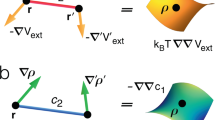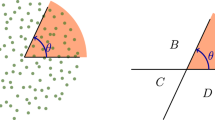Abstract
Fluctuations around some average or equilibrium state arise universally in physical systems. Large fluctuations — fluctuations that are much larger than average — occur only rarely but are responsible for many physical processes, such as nucleation in phase transitions, chemical reactions, mutations in DNA sequences, protein transport in cells and failure of electronic devices. They lie at the heart of many discussions1,2,3,4,5 of how the irreversible thermodynamic behaviour of bulk matter relates to the reversible (classical or quantum-mechanical) laws describing the constituent atoms and molecules. Large fluctuations can be described theoretically using hamiltonian6,7 and equivalent path-integral8,9,10,11,12 formulations, but these approaches remain largely untested experimentally, mainly because such fluctuations are rare and also because only recently was an appropriate statistical distribution function formulated11. It was shown recently, however, that experiments on fluctuations using analogue electronic circuits allow the phase-space trajectories of fluctuations in a dynamical system to be observed directly12. Here we show that this approach can be used to identify a fundamental distinction between two types of random motion: fluctuational motion, which takes the system away from a stable state, and relaxational motion back towards this state. We suggest that macroscopic irreversibility is related to temporal asymmetry of these two types of motion, which in turn implies a lack of detailed balance and corresponds to non-differentiability of the generalized nonequilibrium potential in which the motion takes place.
This is a preview of subscription content, access via your institution
Access options
Subscribe to this journal
Receive 51 print issues and online access
$199.00 per year
only $3.90 per issue
Buy this article
- Purchase on Springer Link
- Instant access to full article PDF
Prices may be subject to local taxes which are calculated during checkout










Similar content being viewed by others
References
Einstein, A. Über die von der molekularkinetischen Theorie der Wärme geforderte Bewegung von in ruhenden Flüssigkeiten Suspendierten Teilchen. Ann. Phys. 17, 549–560 (1905); also transl. in Investigations on the Theory of the Brownian Movement (ed. Fürth, R.) (Dover, New York, (1956)).
Onsager, L. Reciprocal relations in irreversible processes. I. Phys. Rev. 37, 405–426 (1931).
Landau, L. D. & Lifshitz, E. M. Statistical Physics Part 1, 3rd edn (Pergamon, New York, (1980)).
Schulman, L. S. Models for intermediate time dynamics with two-time boundary conditions. Physica A 117, 373–380 (1991).
Bricmont, J. Science of chaos or chaos in science? Ann. NY Acad. Sci. 775, 131–175 (1996).
Cohen, J. K. & Lewis, R. M. Aray method for the asymptotic solution of the diffusion equation. J. Inst. Math. Appl. 3, 266–290 (1967).
Freidlin, M. I. & Wentzell, A. D. Random Pertubations in Dynamical Systems (Springer, New York, (1984)).
Feynman, R. P. & Hibbs, A. R. Quantum Mechanics and Path Integrals (McGraw-Hill, New York, (1965)).
Dykman, M. I. & Krivoglaz, M. A. in Soviet Physics Reviews Vol. 5(ed. Khalatnikov, I. M.) 265–441 (Harwood, New York, (1984).
Bray, A. J. & McKane, A. J. Instanton calculation of the escape rate for activation over a potential barrier driven by colored noise. Phys. Rev. Lett. 62, 493–496 (1989).
Dykman, M. I., McLintock, P. V. E., Smelyanskiy, V. N., Stein, N. D. & Stocks, N. G. Optimal paths and the prehistory problem for large fluctuations in noise-driven systems. Phys. Rev. Lett. 68, 2718–2721 (1992).
Dykman, M. I., Luchinsky, D. G., McClintock, P. V. E. & Smelyanskiy, V. N. Corrals and critical behaviour of the distribution of optimal paths. Phys. Rev. Lett. 77, 5229–5232 (1996).
Kautz, R. L. Noise, chaos, and the Josephson standard. Rep. Prog. Phys. 59, 935–992 (1996).
Dykman, M. I. et al. Noise-enhanced optical heterodyning. Appl. Phys. Lett. 67, 308–310 (1995).
Dykman, M. I., Mori, E., Ross, J. & Hunt, P. M. Large fluctuations and optimal paths in chemical kinetics. J. Chem. Phys. 100, 5737–5750 (1994).
Graham, R. & Tél, T. Existence of a potential for dissipative dynamical systems. Phys. Rev. Lett. 52, 9–12 (1984).
Graham, R. in Noise in Nonlinear Dynamical Systems Vol. 1(eds Moss, F. & McClintock, P. V. E.) 225–278 (Cambridge Univ. Press, (1989)).
Dykman, M. I., Millonas, M. M. & Smelyanskiy, V. N. Observable and hidden features of large fluctuations in nonequilibrium systems. Phys. Lett. A 195, 53–58 (1994).
Maier, R. S. & Stein, D. L. Ascaling theory of bifurcations in the symmetrical weak-noise escape problem. J. Statist. Phys. 83, 291–357 (1996).
Dykman, M. I. Large fluctuations and fluctuational transitions in systems driven by colored Gaussian noise — a high-frequency noise. Phys. Rev. A 42, 2020–2029 (1990).
Einchcomb, S. J. B. & McKane, A. J. Use of Hamiltonian mechanics in systems driven by colored noise. Phys. Rev. E 51, 2974–2981 (1995).
Van Kampen, N. G. Stochastic Processes in Physics and Chemistry (Elsevier, Amsterdam, (1990)).
Berry, M. V. Waves and Thom's theorem. Adv. Phys. 25, 1–26 (1976).
Jauslin, H. R. Nondifferentiable potentials for nonequilibrium steady states. Physica A 144, 179–191 (1987).
Day, M. V. Recent progress on the small parameter exit problem. Schochastics 20, 121–150 (1987).
Maier, R. S. & Stein, DS. L. Escape problem for irreversible systems. Phys. Rev. E 48, 931–938 (1993).
Risken, H. The Fokker-Planck Equation 2nd edn (Springer, Berlin, (1989)).
McClintock, P. V. E. & Moss, F. in Noise in Nonlinear Dynamical Systems Vol. 3(eds Moss, F. & McClintock, P. V. E.) 243–274 (Cambridge Univ. Press, (1989)).
Haken, H. Cooperative phenomena in systems far from thermal equilibrium and in nonphysical systems. Rev. Mod. Phys. 47, 67–119 (1975).
Onsager, L. & Machlup, S. Fluctuations and irreversible processes. Phys. Rev. 91, 1505–1512 (1953).
Zwanzig, R. Nonlinear generalised Langevin equations. J. Statist. Phys. 9, 215–220 (1973).
Acknowledgements
We thank M. I. Dykman for help and encouragement; we also thank him, R. S. Maier and D. L. Stein for comments on an earlier version of the manuscript; and we acknowledge correspondence with N. G. van Kampen. This work was supported by the Engineering and Physical Sciences Research Council (UK), the Royal Society, and the Russian Foundation for Basic Research.
Author information
Authors and Affiliations
Corresponding author
Rights and permissions
About this article
Cite this article
Luchinsky, D., McClintock, P. Irreversibility of classical fluctuations studied in analogue electrical circuits. Nature 389, 463–466 (1997). https://doi.org/10.1038/38963
Received:
Accepted:
Issue Date:
DOI: https://doi.org/10.1038/38963
This article is cited by
-
Coherent structures at the origin of time irreversibility in wall turbulence
Communications Physics (2023)
-
Critical and scaling behavior of delayed bifurcations in nonlinear systems with dynamic disorder
Journal of Chemical Sciences (2023)
-
Origin and control of ionic hydration patterns in nanopores
Communications Materials (2021)
-
Large order fluctuations, switching, and control in complex networks
Scientific Reports (2017)
-
Swirled by light
Nature (2009)
Comments
By submitting a comment you agree to abide by our Terms and Community Guidelines. If you find something abusive or that does not comply with our terms or guidelines please flag it as inappropriate.



